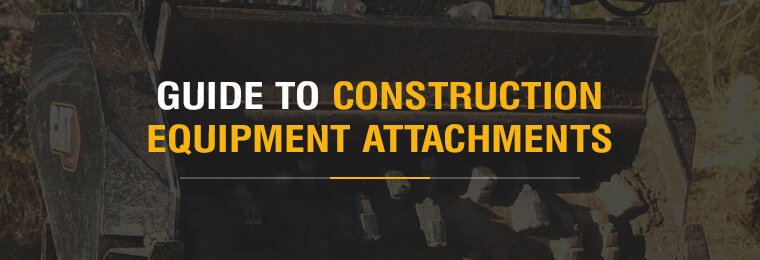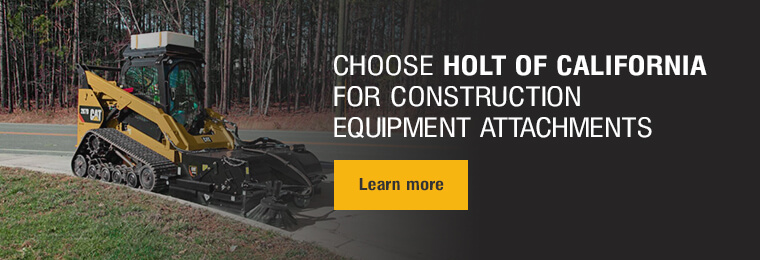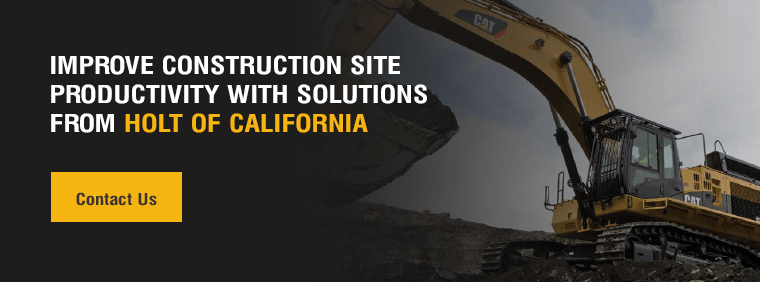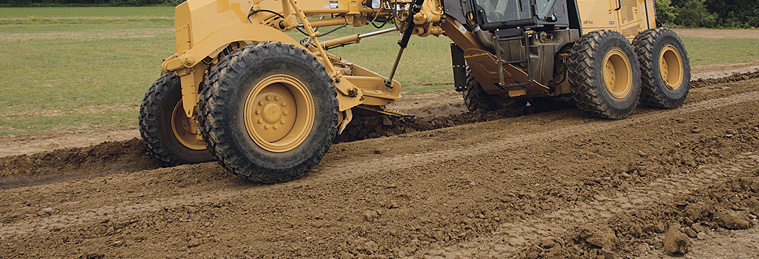
News
The Future of Infrastructure Construction in the Central Valley
- Details
- Category: News

California's Central Valley is experiencing several events requiring significant infrastructure upgrades. These situations have created a need for reliable compact construction equipment like skid steer loaders, mini excavators and compact track loaders, which are available at Holt of California.
Water Management Projects and the Demand for Heavy Equipment
As of 2023, the southern Central Valley is experiencing severe drought conditions. The state's water authorities have allocated $15 million to provide relief through improving the region's water infrastructure. The Department of Water Resources is awarding grants to the city of Bakersfield, the Pixley Irrigation District and the Kings Basin Water Authority under its Integrated Water Management Program.
Because of these and other water and drought-related initiatives, many construction companies will likely need more high-quality machinery for local water projects.
Roads and Railways
The Central Valley is the heart of a state-of-the-art high-speed rail system that will ultimately allow riders to travel between San Francisco and Los Angeles in under three hours. The next step entails connecting the current 119-mile stretch spanning Madera, Fresno, Kings, Tulare and Kern counties to create a 171-mile Merced-Bakersfield line.
Multiple road construction projects are in progress or nearly underway in Kern, Kings, Madera, Fresno, Tulare and Mariposa counties on Interstate 5 and several highly traveled state highways.
Housing Crisis in the Central Valley
The widespread housing shortage is a prominent issue in the Central Valley and other parts of California and has reached the crisis stage in some areas. Homeowners and renters are spending a larger portion of their income on housing costs, which have become prohibitive for many residents.
As the state government continues to allocate funds to various cities and counties for residential building projects, it has created a need for construction machinery for housing. Many contractors will have to increase spending on this equipment to ensure they can meet the demand.
Increased Need for Fleet Management and Equipment Availability
In addition to ramping up their equipment inventory, the construction companies involved in these and other infrastructure endeavors will need to manage their fleet more effectively and efficiently. Implementing practices like condition monitoring and fluid analysis can help keep machines on the job longer and optimize their performance.
Maximizing equipment availability and having the right machines for specific projects will be crucial as the Central Valley's infrastructure needs continue to evolve. The companies that achieve these objectives will have the most success now and in the future.
Contact Holt of California Today
Whether you're looking for compact equipment or other machinery for your construction projects, Holt of California has everything you need. We also provide a range of services to keep your fleet on the job and maximize its life span. Contact us today to learn more.
Benefits of Parts.Cat.Com
- Details
- Category: News
No matter your industry, Parts.Cat.Com (PCC) provides an online ordering system where you can find an inventory of parts and components that you can easily order and have delivered to your job site.
6 Parts.Cat.Com Benefits
When you need Cat parts, turn to Parts.Cat.Com. Discover the parts you need to keep your equipment operating as it should.
Here are six advantages of choosing Parts.Cat.Com.
1. Extensive Inventory
We understand that your job site has unique needs, which is why we offer an extensive inventory on our site. We carry many types of parts, including:
- Air conditioning kits
- Attachments
- Batteries
- Belts
- Cabs
- Cylinder seals
- Drivetrain
- Electronics
- Engine parts
- Filters
2. Easy, Convenient Ordering Process
At Holt of California, we make it easier than ever for you to order the partss and components you need. Instead of leaving the field or office to go to the nearest location, you can shop online - anywhere and anytime.
Easily add multiple parts to your cart and place several orders throughout the year. With the ability to save your company's credit card on file, you'll also be able to enjoy a convenient ordering process that will let you get back to work in no time.
3. PCC Saves Everything You Buy for Future Reference
Another advantage of Parts.Cat.Com is that it will keep a history of everything you buy. Whether you purchase uninterruptible power batteries or head wear rings, our system will save it all. This record makes it easy for you to view past orders whenever you need to restock or replace parts and complements.
4. Input Machine Serial Numbers and Search for Compatible Parts
Access to Parts.Cat.Com means finding the parts and components you need quickly. Some machines may require specific parts, which is why the site has a "Parts Lookup" feature. You can input your machine's serial number to search for compatible parts. With the ability to view information ranging from parts pricing to parts schematics, you'll have access to the information you need to make smart purchasing decisions.
5. Fast Turnaround
Whether you order on your phone or laptop, you can buy the parts you need in no time. We are committed to providing a fast turnaround, which means when you submit your online order, our team will begin processing it to ensure you'll get it delivered as quickly as possible.
6. Easily View and Manage Orders
Once you place an order, we'll keep you updated with several user-friendly tools that make it simple to view and manage your PCC orders. Along with emails notifying you when your order is complete or when it's expected to arrive, you can also view information like invoices.
Order Parts Online at Parts.Cat.Com
When you choose Parts.Cat.Com, you'll have access to our industry-leading support team that will be available to answer your questions about parts or assist with any problems you may have. Shop our inventory of parts and components today and give us a call at 888-288-1460 or reach out online if you need assistance.
Guide to Construction Equipment Attachments
- Details
- Category: News
Quick Navigation
- Earthmoving Attachments
- Landscaping Attachments
- Roadwork Attachments
- Demolition Attachments
- Miscellaneous Attachments
- About Cat® Construction Equipment Attachments
When it comes to heavy construction equipment, some of the greatest innovations from manufacturers have come in the form of the utility of attachments. Construction equipment attachment manufacturers continue to produce multi-purpose and specialty work tools that transform machines into highly applicable solutions for virtually any type of project.
Demand for compact equipment attachments continues to grow as more owner-operators invest in their own tools to help expand their offerings and scale their businesses.
This guide to construction equipment attachments covers the types of work tools available for earthmoving, landscaping, roadwork, demolition and various other applications, and some of the benefits of choosing Cat® attachments for your heavy equipment needs.
Earthmoving Attachments
Earthmoving is an essential stage in the construction process where heavy equipment moves soil, rock and other material in preparation for construction or other industrial activities. Whether it’s moving material for construction, mining or roadbuilding, earthmovers like excavators and loaders rely on a variety of attachments to get the job done.
Below are some of the top earthmoving work tools needed on-site:
- Augers: Drill precise and even holes through compacted earth with auger attachments. Whether you’re installing foundation footings, fence posts or trees, augers and auger bits are capable of penetrating tough earthen materials to create a variety of sizes and depths of holes. Augers are hydraulically powered and built to withstand repetitive, heavy use thanks to their spiral design and durable materials.
- Buckets: Buckets are standard attachments on earthmoving equipment, whether it’s an excavator, a wheel loader or a compact machine like a skid steer. You’ll find many bucket designs available for specific tasks, from multi-purpose material buckets with a straight edge to toothed buckets for grappling uneven materials.
- Grapples: When handling bulky, uneven and loose materials during site preparation, equipment operators use grapples to help secure loads and transport more material with greater efficiency. Compared to open buckets, grapples help operators pick up and hold large materials, like rock and tree debris for easier transportation.
- Rippers: When working with highly compacted earth or material, rippers offer high-impact digging capabilities. A ripper is essentially a heavy-duty steel-toothed claw used to penetrate hard material, like compacted or frozen soil, tearing it apart to make it easier for digging, trenching or installations. Choose rippers for demanding rip-and-load jobs.
- Thumbs: Increase load control on earthmoving projects with thumb attachments for excavator buckets. A thumb is an extra appendage added to the opposing side of the excavator bucket to clamp down on the loaded material and hold it in place while the machine or boom is in motion.
- Trenchers: When you need to cut through soil in a smooth and even slice, a trencher attachment will help you accomplish the job. Trenchers contain a series of heavy-duty teeth rotating from a chain, similar to a large chainsaw. Earthmoving projects that involve laying utility pipes, irrigation lines, power systems or drainage ditches need powerful trenchers to help cut through soil evenly.
Landscaping Attachments
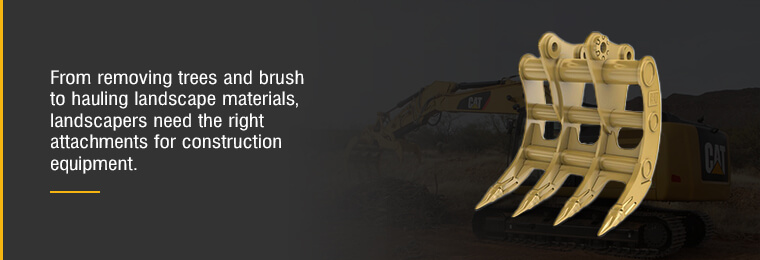
Landscaping contractors come up against many unexpected challenges as they attempt to work, clean and organize landscapes. Having a selection of tools allows contractors to tackle projects with efficiency and productivity, maximizing their time spent working. From removing trees and brush to hauling landscape materials, landscapers need the right attachments for construction equipment.
Below are some of the top types of landscaping attachments:
- Brushcutters: Clear brush and overgrowth quickly with brushcutting attachments for compact loaders. Use a brushcutter to tackle trees up to 8 inches in diameter or clean up tall overgrowth that extends beyond property lines. Brushcutters use a rotary blade to slice through thick and uneven brush, providing a precise way to contour around structures.
- Mulchers: Mulch is a useful and valuable material for landscaping, providing a nourishing ground covering for vegetation, trees and plantings. Mulchers allow landscape contractors to chop up unwanted brush and vegetative debris into fine, even material for repurposing. Mulchers contain multiple layers of heavy-duty teeth that rip and shred material evenly.
- Rakes: In landscape finishing, you need the right tools to help you smooth and level out soil. Rake attachments comb through topsoil, breaking up large chunks of dirt and debris, leaving an even layer of surface material in their wake. Rakes can also be used on other ground coverings, including gravel, mulch or sand.
- Stump grinders: Whether you’re clearing a lot for new construction or cleaning up an existing landscape, you may come across the need to remove tree stumps. Stump grinding attachments give contractors a powerful sawing tool that grinds down stubborn tree stumps into mulch. A stump grinder is a rotary saw blade that moves back and forth and up and down to reduce tree stumps to below surface level.
- Tillers: One of the most useful work tool attachments in the landscaping arsenal is the tiller attachment. Tillers are used to break up and churn soil to aerate it ahead of planting seedbeds or laying down turf. Tillers can also be used to mix and add materials to soil, including fertilizer or compost. Use tillers when fallow earth has been untouched and hardened over time and needs extra force to break it apart.
Roadwork Attachments
Road construction relies on heavy-duty equipment that’s powerful enough to rip up old pavement, reclaim road materials, grade out new roadways and lay down new asphalt or concrete. Leveraging a combination of loaders, dozers, motor graders and pavers, road workers benefit from machines and tools to build solid, long-lasting roads and highways. With various attachments available, crews can maximize their machines' productivity with the right work tools.
Below are the top equipment attachments for road construction:
- Blades: Blade attachments are essential dozing, land clearing and debris removal tools used in road construction. Attaching to bulldozers, wheel loaders and compact loaders, blades come in numerous configurations. Angle blades allow for precise maneuvering of material, while box blades are applied for grading and leveling ground in preparation for paving. Work with your trusted Cat dealer to choose the right type of blade attachment for your heavy construction equipment.
- Brooms: Road construction and maintenance require an efficient cleanup stage with broom attachments that help clear away debris and dirt. Caterpillar is one of the top construction equipment attachment manufacturers, offering three types of broom tools. Angle brooms offer precision attachments for clearing roadways and parking lots, while pick-up brooms provide a way to contain and dispose of debris. Utility brooms are an everyday attachment for ongoing light cleanup and debris containment.
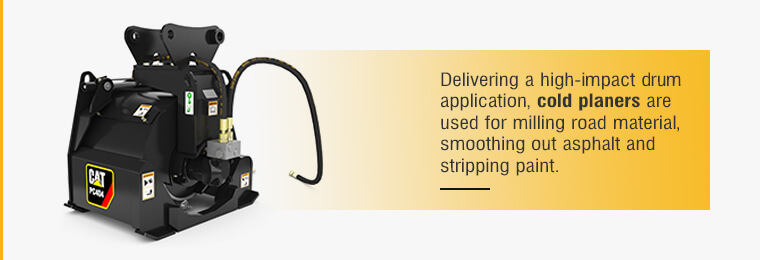
- Cold planers: Cold planers are work tool attachments that are vital to the road resurfacing and paving process. Delivering a high-impact drum application, cold planers are used for milling road material, smoothing out asphalt and stripping paint. Cold planers are compatible with compact loaders like skid steers and full-size equipment, including wheel loaders.
- Compactors: Successful road construction requires heavy-duty tools to compact earth and create a solid foundation for a durable roadway. Compactor attachments compress road materials to remove air pockets and strengthen the layers beneath the road surface to ensure maximum durability and longevity. Compactors are also used for backfilling embankments and slopes or pipeline construction.
Demolition Attachments
Demolition is a fact of development, offering a way to remove, reuse, recycle and dispose of old structures and products that can make way for new purposes.
Primary demolition and processing consist of breaking down decommissioned structures, buildings or bridges that are no longer needed or safe to use. Secondary demolition is the act of processing previously demolished materials for salvaging, recycling or reuse. Whether you’re involved in primary or secondary demolition, you need powerful attachments that are compatible with heavy-duty construction equipment that can withstand this tough work.
Below are some of the most useful heavy equipment attachments for demolition work:
- Hammers: When you need to break up hard surfaces like concrete, pavement or rock, a hammer attachment for your excavator, loader or skid steer is an essential demolition tool. Hammers are hydraulically powered, delivering the vertical impact force and performance needed to cut through hard surfaces. Hammers come in different sizes depending on the type and size of the project at hand.
- Multi-processors: Multi-processors are powerful demolition and concrete cutting tools capable of tackling the toughest jobs. Acting as heavy-duty cutting jaws, multi-processors can reduce even the toughest materials, like steel beams and iron pipes, to ruin. Multi-processors are versatile and useful work tools for excavators running on construction projects, industrial sites, junkyards and more. As the name suggests, multi-processors perform the jobs of several tools combined, including shearing, crushing and pulverizing.
- Pulverizers: For heavy-duty crushing power, employ a pulverizer attachment for your excavator or loader. Built like a jaw, pulverizers have a fixed jaw and a moving one, allowing operators to crush material and move it easily into piles, making it useful in demolition settings where you need to separate material types, such as removing metal scraps from concrete rubble.
- Shears: Shears are high-performance demolition attachments used in steel processing and recycling. Whether you’re dismantling buildings, automobiles or aircraft, shears are a necessary attachment to help cut through and sort solid metals. Shears are also used in secondary capacities, allowing operators to cut metal scraps down to specific sizes for transportation and reuse.
Miscellaneous Attachments
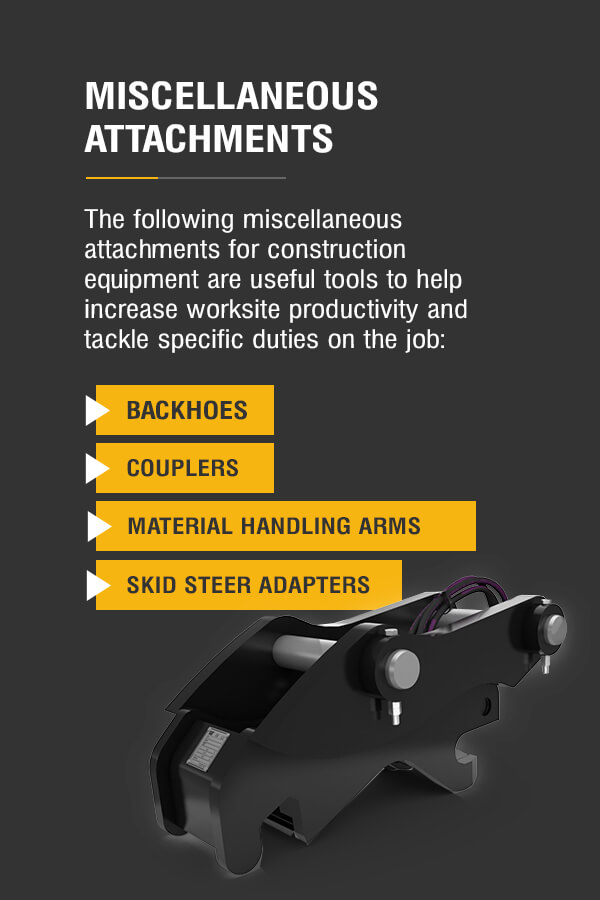
Equipment manufacturers are constantly inventing and refining the types of work tools available for specialty applications and scenarios. The following miscellaneous attachments for construction equipment are useful tools to help increase worksite productivity and tackle specific duties on the job:
- Backhoes: When you want to turn your existing equipment into a multi-purpose unit, choose a backhoe attachment for your loader. Backhoes are one of the most convenient compact construction equipment attachments, allowing you to transform your skid steer into a powerful digging machine. Backhoe attachments allow you to perform tasks like digging foundations, trenching irrigation lines and backfilling and material moving.
- Couplers: When you want to leverage the diverse suite of attachments for construction equipment, you need a coupler attachment to act as the bridge between your existing equipment and the desired work tool. Couplers are available for backhoes, excavators and loaders, allowing you to quickly change between different work tools to save time and maximize productivity.
- Material handling arms: Run a smooth and organized worksite with material handling arm attachments for your heavy construction equipment. Material handling arms come in several lengths and load ratings suitable for different applications. Whether you’re moving building supplies in a lumber yard, lowering pipes into the ground or moving steel beams, material handling arms give you the lifting and carrying capacity you need to operate a productive job site.
- Skid steer adapters: Skid steers are often referred to as the Swiss army knife of construction equipment, as they're compatible with many tools. A skid steer adapter allows these machines to further leverage additional tools that are designed for other types of equipment.
About Cat® Construction Equipment Attachments
Caterpillar is an industry-leading construction equipment attachment manufacturer, providing total system solutions that enhance existing machines’ capabilities. With the right Cat work tools, contractors can expand their service offerings, take on projects year-round and get more work done in less time.
Cat construction equipment attachments offer the following advantages:
- Maximizing existing equipment’s hydraulic systems
- Improving job site safety with the right tools for the task at hand
- Increasing return on investment in heavy equipment
- Optimizing productivity and minimizing downtime
Whether you own Cat equipment or equipment from another manufacturer, you’ll find that Cat attachments are compatible with most machines. For example, Cat attachments designed for compact equipment will perform no matter which machine you use.
When selecting the right Cat attachments, consider the machine size and the size of the work tool. For instance, compact equipment performs best when equipped with smaller attachments to maintain the maneuverability and speed that’s desirable from a smaller machine.
As an owner of equipment attachments, it’s important to know how to adequately store and maintain your tools to maximize their longevity and performance:
- Keep your attachments out of the elements while not in use, securing them in a dry or covered location to prevent corrosion and damage.
- Conduct routine inspections of your attachments, and invest in regular servicing and repairs as needed.
- Perform a pre- and post-operating checklist before and after each use to help ensure safety and protect your investment in your equipment.
Choose Holt of California for Construction Equipment Attachments
When you need reliable, durable and high-performing construction equipment attachments, choose Caterpillar as your trusted manufacturer. Holt of California is a leading provider of new and used Cat equipment attachments. Browse our inventory of work tools to learn more, and discover our wide range of Cat construction equipment for sale.
Get help selecting the right construction equipment attachment for your application. Contact Holt of California today to speak with an equipment representative who can help you choose the right type and size of attachment for your needs. Call us today at 800-452-5888 or visit one of our convenient locations throughout California.
The Benefits of a Cat® Customer Value Agreement
- Details
- Category: News
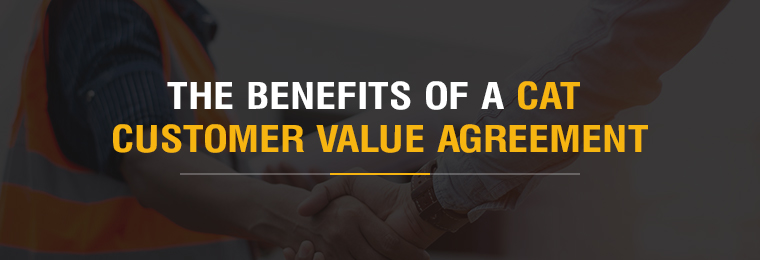
Quick Navigation
- What Is a Cat Customer Value Agreement?
- The Benefits of a Customer Value Agreement
- Set Up Your Fleet With a CVA From Holt of California
Every piece of Cat® equipment is engineered to deliver reliability and maximum productivity throughout its working life. The addition of a Customer Value Agreement (CVA) can help construction workers and site managers extend the lifetime of their heavy equipment through planned maintenance, all while minimizing downtime and reducing production costs. CVAs also lessen the burden of fleet maintenance and hand the management of your heavy machinery over to your Cat dealer.
A CVA is an excellent solution if you're looking for ways to maximize your investment in your next equipment purchase or fleet upgrade. Learn more about Customer Value Agreements from Caterpillar and why you should consider adding one the next time you upgrade your heavy machinery.
What Is a Cat Customer Value Agreement?
A Customer Value Agreement with Caterpillar is an ownership and maintenance agreement between the owner and dealer that provides a tailor-made services package and enables hassle-free ownership. A CVA lets you benefit from additional maintenance services to maximize your equipment investment. Owners can sign a CVA on new or used equipment, giving them access to beneficial services, whatever their business goals.
By utilizing a CVA, equipment owners can prevent premature component failure and reduce unexpected maintenance costs to maximize uptime and increase the fleet's productivity. These ownership plans fit your business needs by helping you reduce the cost of ownership and avoid expensive machine breakdowns.
A CVA can include a range of services, depending on the industry and type of product. Keeping construction equipment in top shape is a good move whatever your industry, and the services included in a CVA can help. A CVA might consist of:
- Preventive maintenance kits
- General machine inspections
- Fluid and oil changes
- Total cost performance guarantees
- Fluid analysis
- Remote monitoring
- Proactive equipment repair
The Benefits of a Customer Value Agreement
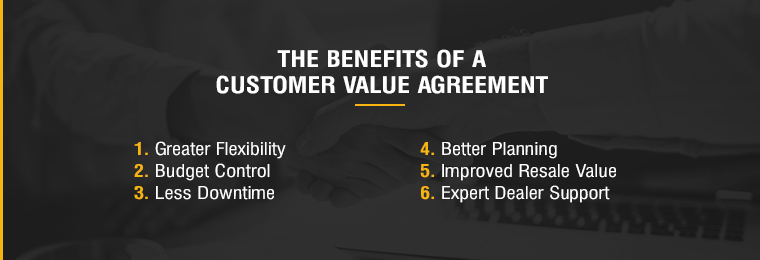
A lot goes into owning a construction business, from supervising your crew to managing your fleet. Having a CVA can reduce that strain and provide several other advantages. Consider some of the top Customer Value Agreement benefits:
1. Greater Flexibility
Every CVA is customizable and scalable to each equipment owner's business needs. You may choose to receive simple preventive maintenance kits or go all-in for the total cost performance guarantee. Whatever your preferences, you can adjust your CVA to provide the services you need. Equipment owners can customize their CVA with several options, including the:
- Number of machines covered
- Length of the CVA
- Range of services provided
You can also modify your CVA at any time if the agreement no longer serves your changing needs. Since a CVA is a voluntary agreement rather than a long-term contract, giving equipment owners greater flexibility in meeting their business needs. You can also cancel your CVA at any time if you wish. The only requirement is that you provide your dealer with a 30-day notice.
2. Budget Control
The preventive maintenance services in a Cat CVA empower equipment owners to control their budgets better. Business owners want to avoid damaged components and unexpected production delays, which can be costly. A regular planned maintenance schedule reduces or eliminates these surprises and can save businesses time.
Business owners and project managers can also benefit from the flexible CVA payment options Cat dealers offer. You can select from paid-in-dull, financed or flat rate options, plus various payment plans like monthly, quarterly, semiannual and annual payments. You may also pay for your CVA based on actual production hours. Your Cat dealer team will help you create the best payment plan for your business.
3. Less Downtime
Being proactive with machine maintenance can improve productivity on the job site and decrease downtime. Catching and repairing damage before a component fails can save your business a considerable amount. Knowing which repairs are coming up beforehand lets you maximize your available fleet and schedule downtime to make your business more efficient.
With planned maintenance and regular machine servicing, your fleet's components can run more efficiently over time. Machine engines can operate longer, and construction equipment attachments can work without excessive parts damage.
4. Better Planning
Advanced machine diagnostics from your Cat dealer help identify issues before they worsen and give you a clear roadmap for repairs. You can schedule repairs before components fail and stick to a tight maintenance schedule to give each machine the attention it needs.
With a CVA, your fleet can also experience fewer unplanned repairs. Ultimately, a CVA improves efficiency and saves time managing equipment breakdown.
5. Improved Resale Value
Performing routine planned maintenance on a piece of heavy machinery is an excellent strategy for improving its resale value. Over time, operating a machine with poor quality fluids, minor damage and other seemingly small issues can cause problems to escalate and result in costly repairs. Planned maintenance reduces these types of repairs to keep your machines running smoothly throughout their operating life.
When you decide to sell, keeping your machines in good condition will provide a better return on your investment. You'll also have extensive maintenance records to track ownership costs.
When you add a CVA to the purchase of any Cat equipment, you also gain the expert service of our professionally trained technicians. Our technicians are certified to maintain Cat equipment and provide various services, including:
- Oil analysis and oil change
- Machine inspections
- Guaranteed service intervals
- Remote monitoring
- More extensive repairs
6. Expert Dealer Support
When you add a CVA to your Cat machine, you benefit from advanced dealer support, including everything from technician repair services to dealer advice:
- Professional technicians: Caterpillar technicians are trained with specialist knowledge to understand the technology in your machines and perform expert repairs.
- CVA advice: Your local Cat dealer offers advice concerning setting up and optimizing your Cat machine and will help you make any modifications to your agreement.
- Parts acquisition: Cat dealers will coordinate parts acquisition to ensure you get the parts you need on time and at the correct location.
- Operator training: Your Cat dealer may also offer operator training with your CVA, so you can ensure your operators are making the best use of their equipment's features.
Set Up Your Fleet With a CVA From Holt of California
Proactively maintaining your heavy equipment fleet is vital to minimizing downtime and costs. With a Customer Value Agreement from Holt of California, you can protect your machinery by sharing its management with an experienced team of trained Caterpillar technicians. Holt of Calfornia offers customizable CVAs with maintenance services that help ensure you get the most out of your machines.
When you partner with Holt of California, you get more than high-quality equipment — you also get access to expert dealer support that provides the parts, service and information you need. Our knowledgeable staff is ready to help with your heavy equipment needs, whatever your industry.
With 16 convenient locations throughout California, Holt of California is your source for Cat construction equipment, parts and service. Learn more about Holt of California CVAs or contact us to speak with our team about your CVA options.
How to Improve Construction Site Productivity
- Details
- Category: News
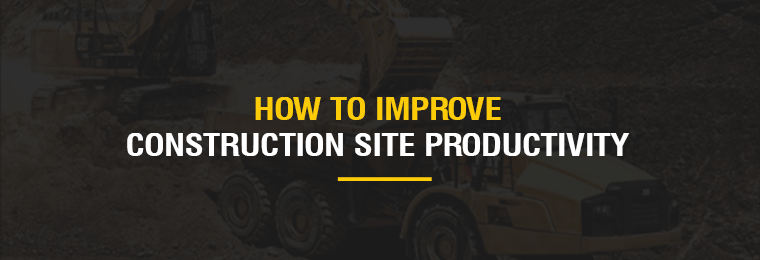
Quick Navigation
- Be Proactive With Maintenance
- Maintain a Strong Communication Culture
- Invest in Your Team
- Prioritize Safety
- Attract Top Talent
- Minimize Downtime With the Right Equipment and Technology
- Improve Construction Site Productivity With Solutions From Holt of California
The construction industry is currently facing a skilled labor shortage. Companies must maximize their current crews and resources to compensate for the lack of workers. In a perfect world, employees and equipment alike would always work in harmony to meet production quotas and deadlines.
But in the real world, things go wrong.
Inefficient practices and malfunctioning equipment hinder productivity and frustrate crews. Plus, lost time decreases your reputation and costs your company money.
Effective management is critical for improving site productivity in the construction industry. For example, keeping proper fleet maintenance records will keep equipment from breaking down. Beyond investing in your equipment, you should focus on your team to demonstrate your appreciation to employees, streamline communications and maximize safety.
Keep reading to discover how to improve productivity on a construction site through best management practices and modern technology.
Be Proactive With Maintenance
If your equipment has failed during a job, you know how frustrating — and unproductive — a lack of preventive maintenance can be. When machines malfunction, jobs may become delayed, discouraging your team. The more time repairs take, the less time your crews can spend working.
Recognizing when you need to replace or repair equipment is crucial to managing a productive workforce. However, waiting for reactive maintenance after something goes wrong leads to unplanned downtime. In contrast, preventive maintenance helps fight regular wear and tear. Preventing minor issues from snowballing into more substantial problems keeps equipment in top condition to increase construction site efficiency.
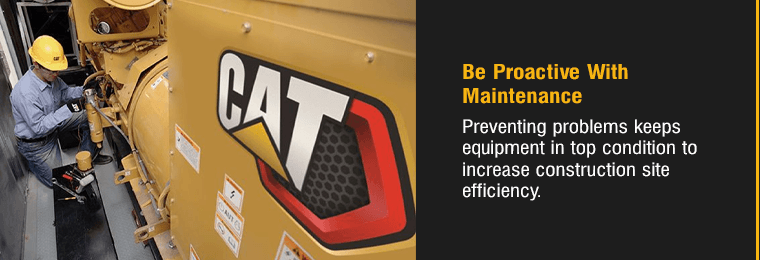
You should consistently inspect your equipment to ensure it's properly working, monitoring:
- Grease and grease filters
- Clean air filters
- Oil filters and levels
- Coolant and hydraulic fuel levels
- Roadworthiness
When surveilling equipment, you should understand what to look for. Keep an eye out for the signs it might be time to repair a machine:
- Cracks on the frame and along welds
- Wear on the tracks, treads and tires
- Windshield cracks, chips and dents
- Wear on the bucket
Appropriately maintaining your equipment maximizes your return on investment, which you can calculate by comparing a fleet's value with its operating costs.
You can maintain a fleet portfolio virtually to eliminate the need to keep track of paperwork, while collecting more data about your equipment, such as operating costs and hours. Apps like Cat App: Fleet Management from Caterpillar optimize fleet management. Access fleet location, service meter units, instructional videos and fleet operation and maintenance manuals all in one place. Plus, you can contact our service team right from a job site.
When you first buy or rent a piece of equipment, ask your dealer about their service options. Keeping a regular maintenance schedule with your dealer will increase your fleets' lifespan. Plus, you can get the best equipment upgrades for your company when it's time to replace your fleets. After all, who knows your machines better than the dealer? Reputable dealers can provide the most reliable Cat parts made for your equipment.
Services like S.O.S. Fluid Analysis monitor fleets so you can keep them safely running and extend their lifetime. You'll optimize inspection and oil change intervals and decrease maintenance time through regular monitoring. Tracking wear and tear informs you when vehicles require maintenance. Then, a certified service technician can directly and immediately target the problem before a minor problem becomes significant.
Maintain a Strong Communication Culture
If something goes wrong on a job site, it's instrumental your team can quickly communicate with management. Creating a robust communication culture is crucial for maximizing construction site productivity, as employees will immediately know who to contact, even before accidents happen. Delays and material shortages hinder productivity on construction sites. If team members know how to reach the right person, incidents will take less time, and your team will have fewer frustrations.
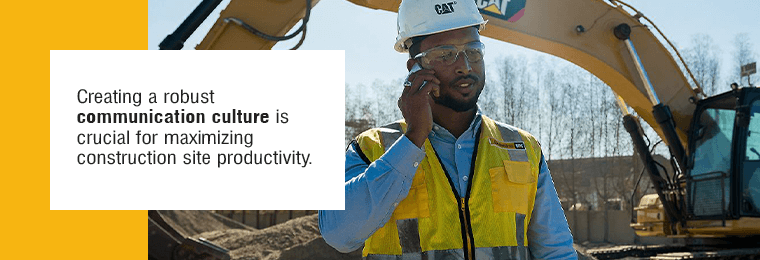
Typically, the people in the field are the first ones to encounter a problem on a job site. Check in with employees to ensure they know who their primary and secondary contacts are. You'll also want to keep their contacts updated when your company brings on new hires.
Work with your team to create and implement an airtight communication plan. Everyone at your company should use a consistent communication platform to report minor incidents promptly. If possible, company phones — furnished with sturdy cases — can provide team members on-the-go access to each other. You'll increase productivity, as employees will spend more time on site instead of in the office.
Part of a communication plan should be keeping your teams versed on future projects. Allow your teams access to information about their work schedules in the future. That way, you'll avoid paying employees unexpected overtime.
Further, you should get to know your employees to build a culture based on trust. They'll feel valued, and you'll understand how to best manage, assign and motivate different parts of your team. Maintaining a relationship with your employees will also alleviate your stress. You'll be able to direct your energy where it's most necessary, rather than spending resources on constant re-hiring. And if you are hiring, being an outstanding employer makes you more likely to attract the top talent you need.
Invest in Your Team
Your employees are one of your company's most valuable assets. One of the best ways to make your construction site more efficient is motivating your team and identifying weak spots. Assess where your employees require the most support. Do they need more supervision, or do they struggle to communicate with the rest of the team? By recognizing where your team is performing well and areas for improvement, you can maximize your resources.
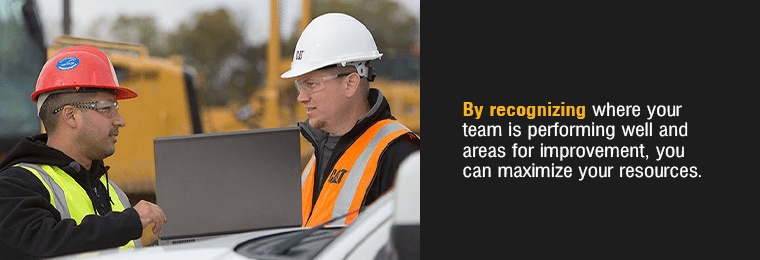
Getting to know your employees will boost productivity. However, your employees will also feel more valued as humans rather than laborers. When people are more satisfied in their jobs, they're typically more productive. Maintaining a positive relationship with crews also reduces employee turnover, minimizing the need to retrain new hires.
Hire well-trained team members, then implement regular retraining programs, especially when you purchase new equipment. When your team doesn't understand how to use your fleets, it leads to a disorganized work site. Proper training protects your workers from workplace accidents and prevents costly equipment damage. Plus, your team will spend less time trying to figure out how to operate your equipment.
You can also claim tax deductions and apply for tax credits that support professional development. Construction companies can claim trade school tuition costs, subscriptions to trade publications, industry association memberships and licensing fees. Further, the American Opportunity Tax Credit and Lifetime Learning Credit can help with education costs — up to $2,500 and $2,000 per year, respectively, for each student. Investing in your team's professional development and growing their skills can help improve productivity at construction sites.
Pushing equipment for long hours might seem necessary to meet quotas. However, overworking equipment can cause malfunctions and make your team fatigued. Appropriate scheduling makes your employees feel valued and safer, increasing productivity on construction sites. Getting to know employees and recognizing stress signals will help you plan for potential setbacks. You can identify and prevent problems before they happen, and your employees will feel more comfortable.
Prioritize Safety
You should also plan for emergencies and account for risk during the project planning phase. Unexpected malfunctions lead to unplanned downtime and could even shut down a smaller or less stable company. If you take time to create a safety and emergency protocol, you can improve construction site efficiency — even when problems happen.
Construction is a dangerous job, with one in five deaths in private industry happening in construction in 2019. Take time to determine how your staff will manage and respond to emergencies when they happen. Because nearly all emergencies result from unsafe behavior, you should train employees in workplace best practices to maximize safety. Establish clear safety protocols and ensure all members of your team understand procedures.
Though accidents delay or could even halt a job, downtime is the least of your worries if a severe accident happens. Plan how you'll provide counseling in case of severe injury or death. Some team members may require more flexibility with scheduling after an incident. Employees could also run out of tasks if a major project gets canceled. Limit downtime by scheduling backup projects.
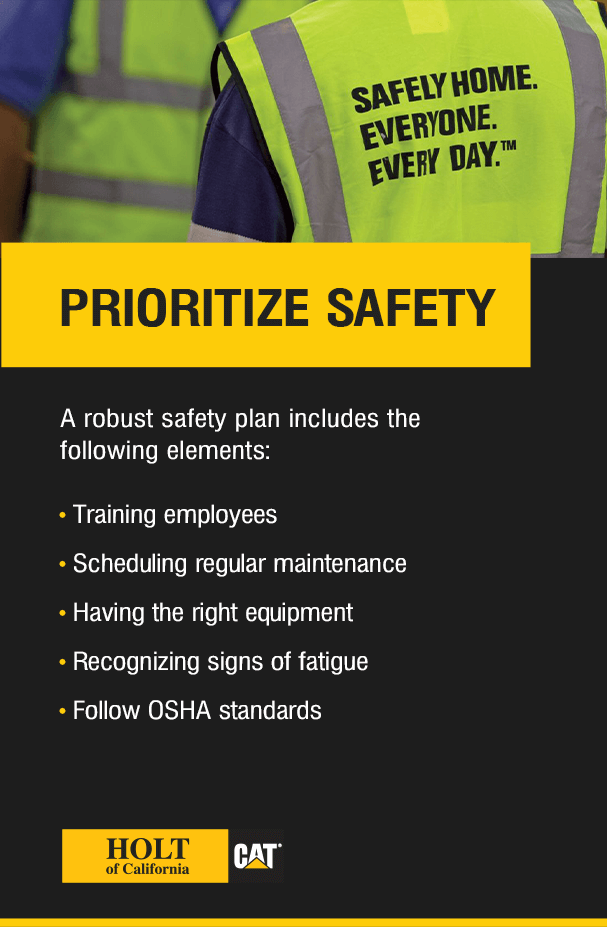
A robust safety plan includes the following elements.
- Training employees: Train all workers in safety protocols and how to operate equipment. Workers should know to keep 10 feet of clearance between equipment and power lines. They should also acknowledge load limits and which attachments are appropriate for which machines. For example, an operator could get hurt if they stand in a location other than a footrest or fail to safely enter and exit equipment. Training will help employees feel more confident if an accident does happen.
- Scheduling regular maintenance: Regular maintenance will keep your fleets running smoothly, preventing unexpected equipment failure. However, malfunctions can also hurt your employees. Protect employees with preventive maintenance and regular inspections. Check both normal functioning of different equipment and safety mechanisms like seat belts, reverse alarms and the rollover structure.
- Having the right equipment: Personal protective equipment prevents injury, ultimately making your workers feel safer and reducing the risk of downtime. Depending on the task at hand, team members on site will need hard hats, eye protection, gloves, face shields or even respirators. Train employees on how to use PPE and enforce regulations while on site.
- Recognizing signs of fatigue: Burnout leads to decreased productivity, hurting your bottom line. What's more, your workers could become injured if they're fatigued. Set appropriate overtime hours and recognize when your employees are becoming tired. Working in intense climate conditions like extreme heat or cold can pose a risk to workers. Recognize the signs of heat exhaustion, heatstroke and hypothermia so you can protect your team members. Practices like taking breaks to cool down or warm up will increase productivity in the long run.
- Follow OSHA standards: Employees operating heavy machinery and equipment must have the appropriate training. Employees can hurt themselves and others or break expensive equipment if they misuse machinery. Following OSHA standards prevents workers from injury and keeps your company from facing legal fees.
Attract Top Talent
The U.S. is currently experiencing a shortage of skilled construction labor. The recession that happened in the late 2000s first hindered the industry. Then, the COVID-19 pandemic worsened the problem. Baby boomers, who compose a significant percentage of the workforce, are also reaching retirement age. Because of the fallout from the recession and pandemic, the industry will need 2 million new workers over the next three years to fill the labor shortage.
Though it may currently be challenging to find skilled labor, you can take the following steps to attract top talent.
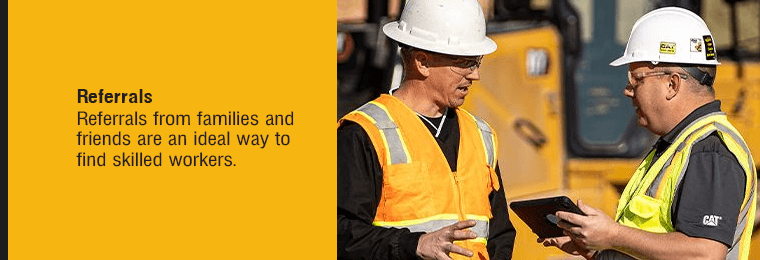
- Referrals: Referrals from families and friends are an ideal way to find skilled workers. You can partner with local high schools, trade and vocational schools and colleges. Your company can also work with recruiting agencies specifically for construction companies.
- Salary: Offering a high starting salary and good benefits gives your company a competitive advantage. Accidents happen in the construction industry, so employees need benefits. Providing a generous starting salary and extensive benefits package will attract and keep highly qualified candidates. Discuss with your team which benefits are most attractive. For example, you might decide to offer 401(k) contributions.
- Flexible schedules: Allowing employees to flexibly schedule is a valuable workplace perk that will persuade skilled workers to stay loyal to your company for longer. Technology makes communication — and ultimately, flexible scheduling — much more accessible than in the past. Workers will feel valued as individuals rather than for their labor alone.
- Robust training and onboarding: Consider offering free — or maybe even paid — training opportunities. Because many construction workers are nearing retirement age, establish a mentorship culture at your company. Workers who have amassed more years of industry experience can pass their knowledge onto new generations. Further, you should offer professional development opportunities so your employees can stay up to date on industry trends.
- Reach out: Consider searching for talent in other demographics from what your business reached out to historically. The U.S. Bureau of Labor Statistics reports that women only account for about 11% of the workforce — more than recent years. Further, nearly the entire industry is white, with Black workers accounting for 6% and Asians representing a slim 2% of workers. You could consider recruiting candidates from diverse backgrounds to grow your company.
- Practice safety: Construction job sites come with various hazards. Minimize the chance of accidents for your team through a strong safety program. Implementing a robust safety program will give potential team members peace of mind. Offer OSHA-certified training courses, so your employees know how to operate machines properly. Further, make your team feel appreciated through wellness initiatives. Providing mental health services and health education will contribute to more healthy, happy and productive employees.
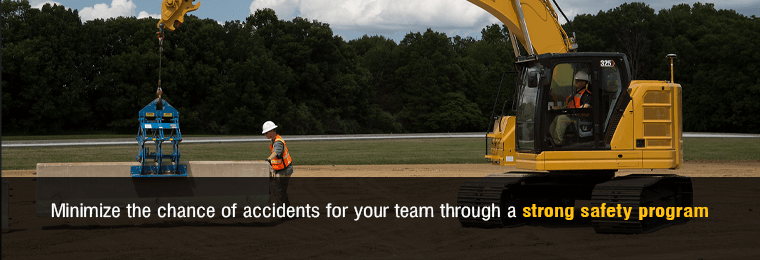
Minimize Downtime With the Right Equipment and Technology
Before heading to a job site, ensure you have the appropriate equipment. You can maximize your machinery and only get what you need by only buying fleets you use frequently. By renting specialty equipment for particular jobs, you can cut costs and have fewer permanent fleets to manage. Improved productivity on construction sites and across your entire company will result in a higher ROI.

When choosing fleets for a job, consider the specific tasks you need to accomplish. Then, decide which equipment will most efficiently and effectively solve the challenge at hand. For example, oversized fleets waste money, while too-small fleets may put your teams behind schedule. If you select the right equipment from the start, crews will more efficiently complete their work.
Beyond picking the correct equipment, you'll want to leverage modern technology to ensure fleets complete the required tasks in the right locations. Apps like VisionLink are one of the best ways to make your construction site more efficient. You'll be able to see when machines are running, their locations and unsafe driving practices from one place.
VisionLink includes four major applications to increase productivity while cutting costs.
- Unified Fleet: This app houses data for fleet management, including equipment location, fuel use, inefficient practices like idling and general operation. Proper fleet management allows for more efficient scheduling and fleet use.
- Unified Service: You can view maintenance data in the Unified Service application, which stores inspection data. Monitoring data from all fleets in one interface streamlines the equipment maintenance and replacement process. Plus, this data will help you identify unsafe practices, so you can quickly remedy them.
- Unified Productivity: As its name suggests, this app tracks efficiency data like machine use, payload, product productivity, volume and cycles. Unified Productivity is also ideal for identifying training and incentive opportunities.
- Administrator: The Administrator app streamlines administrative tasks. Office staff will manage asset settings, notifications, users, groups, projects and reports.
The Cat Productivity app is another excellent option for boosting management and productivity at construction sites. One of the most notable benefits of this app is that it's cloud-based. That means multiple users can view and manage equipment and job data from any location and device with an internet connection.

The app improves productivity in ways like these.
- Maximizing efficiency: Cat Productivity can track individual assets, allowing you to see which fleets are less productive. Further, metrics like hourly fleet performance streamline daily operations. Data helps managers optimize shift changes, breaks and refueling. The app also tracks hours working and idle, fuel burn and map view to increase fuel efficiency by 23%.
- Setting production targets: Develop and reach production targets more efficiently with Cat Productivity. The app displays the number of loads made in a day and weekly load counts. Machine activity data like load times, fill levels, cycle segments and positioning will also improve cycle time by 20%.
- Managing multiple job sites: You can manage several jobs and even view a summary and relevant metrics about all jobs from a single screen.
- Locating fleets: GPS trackers locate all your fleets and how long it takes them to arrive at a location. You can set up geofences, or virtual borders, to see when vehicles leave approved areas.
- Tracking costs: The most productive construction sites are also cost-efficient. Cat Productivity breaks down different costs, including fuel costs and consumption, trends and total site costs. Daily cost breakdowns will help you analyze where you can cut spending without sacrificing productivity.
Improve Construction Site Productivity With Solutions From Holt of California
For more than 95 years, Caterpillar has provided safe, reliable heavy equipment for multiple industries. At Holt of California, we're proud to offer new and used equipment, parts and heavy equipment rentals. Plus, our professional teams will service your equipment to keep it running in top shape. Contact us today or request a quote to experience our excellent customer service and world-class products!


